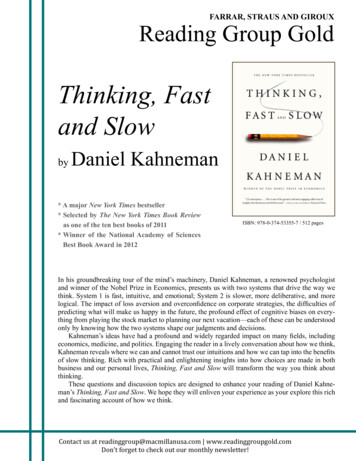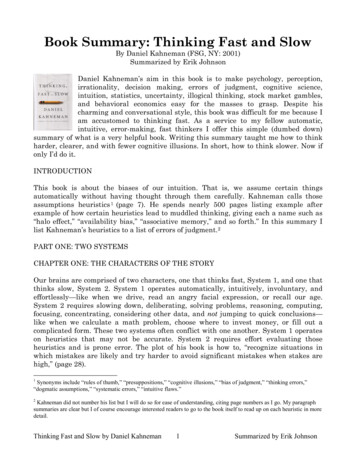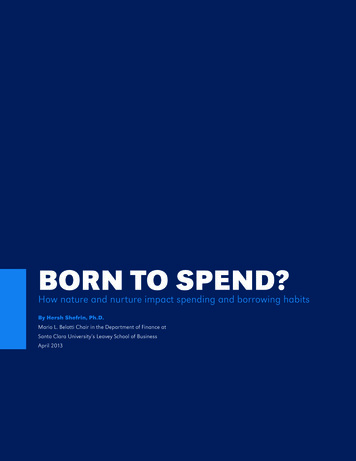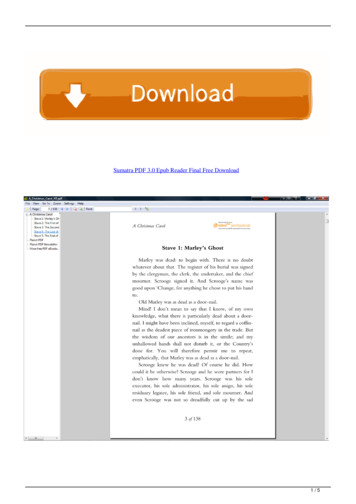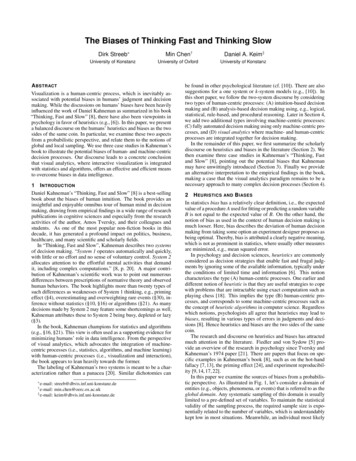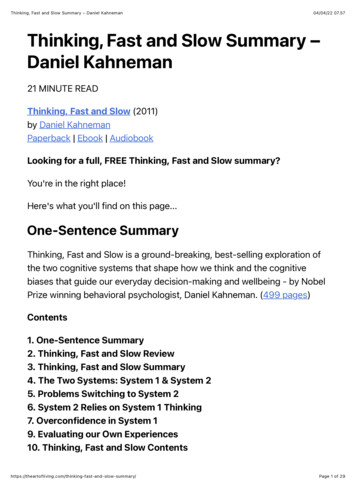
Transcription
Thinking, Fast and Slow Summary – Daniel Kahneman04/04/22 07.57Thinking, Fast and Slow Summary –Daniel Kahneman21 MINUTE READThinking, Fast and Slow (2011)by Daniel KahnemanPaperback Ebook AudiobookLooking for a full, FREE Thinking, Fast and Slow summary?You're in the right place!Here's what you'll find on this page.One-Sentence SummaryThinking, Fast and Slow is a ground-breaking, best-selling exploration ofthe two cognitive systems that shape how we think and the cognitivebiases that guide our everyday decision-making and wellbeing - by NobelPrize winning behavioral psychologist, Daniel Kahneman. (499 pages)Contents1. One-Sentence Summary2. Thinking, Fast and Slow Review3. Thinking, Fast and Slow Summary4. The Two Systems: System 1 & System 25. Problems Switching to System 26. System 2 Relies on System 1 Thinking7. Overconfidence in System 19. Evaluating our Own Experiences10. Thinking, Fast and Slow nd-slow-summary/Page 1 of 29
Thinking, Fast and Slow Summary – Daniel Kahneman04/04/22 07.5711. Thinking, Fast and Slow FAQs12. Why Do I Think Fast and Slow?13. What is the Difference Between Fast and Slow Thinking?14. Is Thinking Fast and Slow Worth Reading?15. Best Thinking, Fast and Slow Quotes16. Wish There Was a Faster/Easier Way?Note: This Thinking, Fast and Slow summary is part of an ongoingproject to summarise the Best Books on Critical Thinnking and Best SelfHelp Books of all time.Thinking, Fast and Slow ReviewThinking Fast and Slow cuts to the heart of decision-making. It examinesthe fundamental cognitive processes we use day-to-day. It’s no simpleself-help ‘recipe’. But if you’re interested in challenging the basis of yourthinking, then it makes for a fascinating read.As you might expect from a Nobel Prize-winning psychologist, the book isinformation-rich. It’s packed full of economic science, behavioral studies,and personal anecdotes.Despite this, Kahneman’s conversational style makes it easy to keepturning pages. But this is one book you don’t want to race through! Irecommend taking it slow (yes – I’m already putting the book’s insightsinto practice!) so you have time to digest its ideas, and consider how theyapply to your psychological nature.Why? Because changing mental processes is hard. You may even feeldefeated as Kahneman reveals just how deep our biases run, and howflawed our sense of voluntary control really is.But you’ll also quickly learn to identify the type of thinking you’re applyingto situations. Which will help you question your assumptions and slow-summary/Page 2 of 29
Thinking, Fast and Slow Summary – Daniel Kahneman04/04/22 07.57making better decisions.There’s no way to summarise a good book without losing importantinformation, so I strongly recommend reading the original.For now, though, here’s TAoL’s book summary of Thinking, Fast and Slow Thinking, Fast and Slow SummaryThe Two Systems: System 1 & System 2Kahneman tells us we use two systems for thinking.System 1 is a fast thinker. We use it to rapidly recall facts we know well,like the capital of France. We also use it to intuitively process informationwe need quickly, like discerning emotions from facial expressions. System1 requires little effort and can make quick decisions.System 2 is a slow thinker. This is the conscious decision-maker. It useslogic to tackle complex computations that are too difficult or unfamiliar forSystem 1, like math problems. We also use it to intentionally control ourbehavior, like staying polite when we’re angry. System 2 requires attentionand effort.System 1 lets us respond quickly and instinctively to a wide range offast and ever-changing inputs. System 2 is more thorough andlogical but also slower and more resource intensive.Splitting thinking between System 1 and System 2 usually works well.System 1 takes care of low-level tasks. System 2 only takes over whenSystem 1 fails because of difficulty, time pressure, or novelty (newinformation).This is an efficient and effective way for our minds to operate because wehave limited mental energy. To preserve it, we use System 1 by d-slow-summary/Page 3 of 29
Thinking, Fast and Slow Summary – Daniel Kahneman04/04/22 07.57and only switch to System 2 when required.(Note: There’s a proposed a link between IQ and our ability to switch toSystem 2. A study – recently challenged – gave four-year-olds a choice toeat a snack immediately or wait fifteen minutes for a larger reward. Thosewho waited demonstrated self-control and activation of their System 2,and years later scored higher on IQ tests.)Problems Switching to System 2Mistakes happen when switching to System 2 doesn’t happenappropriately.This makes us fall back on the learned behaviors and shortcuts(‘heuristics’) of System 1 when we shouldn’t, which leads to cognitivebiases that sabotage thinking and decision making.Here’s a full list of biases and ideas covered in this Thinking, Fast andSlow gnitive EaseCreating New NormsConfirmation BiasThe Halo EffectIntuitive JudgementsSubstitutionThe Law of Small NumbersAnchoring EffectAvailability BiasRepresentativenessThe Conjunction FallacyCauses Trump StatisticsRegression to the low-summary/Page 4 of 29
Thinking, Fast and Slow Summary – Daniel Kahneman15.16.17.18.19.20.21.22.23.24.25.04/04/22 07.57Taming Intuitive PredictionsHindsight BiasExpert IntuitionInsider BlindnessExcessive OptimismUtility TheoryProspect TheoryLoss AversionEndowment EffectThe Fourfold PatternContextClick a concept or cognitive bias to jump to its explanation.Or read on as we dive in below PrimingPriming happens when exposure to one idea makes you more likely tofavor related ones.For example, when asked to complete the word fragment SO P, peopleprimed with ‘eat’ will usually complete SOUP. Meanwhile, people primedwith ‘wash’ will usually complete SOAP.System 1 helps us make quick connections between causes andeffects, things and their properties, and categories. By priming us (i.e.,“pre-fetching” information based on recent stimuli and pre-existingassociations) System 1 helps us make rapid sense of the infinite networkof ideas that fills our sensory world, without having to analyze everything.Priming usually works because the most familiar answer is also the mostlikely. But priming causes issues when System 2 leans on theseassociations g-fast-and-slow-summary/Page 5 of 29
Thinking, Fast and Slow Summary – Daniel Kahneman04/04/22 07.57Instead of considering all options equally, System 1 gives ‘primed’associations priority instead of relying on facts.Cognitive EaseCognitive Ease describes how hard we think a mental task is.It increases if the information is clear, simple, and repeated.Biases happen when complex information (requiring System 2) ispresented in ways that make problems look easier than they reallyare (falling back on System 1).For example, researchers gave students the following puzzle: “A bat andball cost 1.10. The bat costs one dollar more than the ball. How muchdoes the ball cost?”The question is not straightforward and needs System 2 to engage. Butresearchers found that System 1 often responds with an intuitive,incorrect answer of 10 cents (correct 5 cents).Interestingly, when the students saw the question in a less legible font,cognitive ease decreased. Far fewer made the error because System 2was more likely to engage.Because we try to conserve mental energy, if cognitive ease is high, andour brain thinks it can solve a problem with System 1, it will not switch toSystem 2.Note: Advertising has long used this technique to persuade people tomake instinctive purchase decisions. A good mood can also fool us into astate of cognitive ease.Creating New NormsSystem 1 uses norms to maintain our model of the world, ow-summary/Page 6 of 29
Thinking, Fast and Slow Summary – Daniel Kahneman04/04/22 07.57constantly updates them. They tell us what to expect in a given context.Surprises should trigger the activation of System 2 because they areoutside of these models. But if new information is presented in familiarcontexts or patterns, System 1 can fail to detect this and fall back on old‘norms’.For example, when asked “How many animals of each kind did Moses takeinto the ark?”, many people immediately answer “two”. They do notrecognize what is wrong because the words fit the norm of a familiarbiblical context (but Moses Noah).Failing to create new norms appropriately causes us to construct storiesthat explain situations and ‘fill in the gaps’ based on our existing beliefs.This leads to false explanations for coincidences, or events with nocorrelation (also known as ‘narrative fallacy’).Confirmation BiasConfirmation bias is our tendency to favor facts that support ourexisting conclusions and unconsciously seek evidence that alignswith them.Our conclusions can come from existing beliefs or values, or System 1norms. They can also come from an idea provided to us as a System1prime.For example, if we believe that “Republicans are out to destroy our way oflife”, we’ll subconsciously pay more attention and give more credit toevidence that confirms that belief while dismissing evidence thatcontradicts it. (And vice versa for Democrats.)Confirmation bias affirms System 1 norms and priming. System 1 tends toprioritise evidence that supports pre-existing ideas. It will also discountevidence that contradicts slow-summary/Page 7 of 29
Thinking, Fast and Slow Summary – Daniel Kahneman04/04/22 07.57The Halo EffectThe halo effect is confirmation bias towards people. It’s why firstimpressions count.In one study, experimenters gave people lists of traits for fictitiouscharacters and found that participants’ overall views changed significantlyjust based on the order of the traits (positive or negative first).The halo effect also stretches to unseen attributes that areunknowable and unrelated to the initial interaction.For example, friendly people are also considered more likely to donate tocharity and tall people are perceived as more competent (which may helpexplain the unexpectedly high number of tall CEOs in the world’s largestcompanies).System 1 struggles to account for the possibility that contradictoryinformation may exist that we cannot see. It operates on the principle that“what you see is what you get”.Intuitive JudgmentsSystem 1 helps us make quick, sometimes life-saving judgements.From an evolutionary sense, this helped us scan for and avoid threats. ButSystem 1 also has blind spots that can lead to poor analysis.For example, System 1 is good at assessing averages but very poor atdetermining cumulative effects. When shown lines of different lengths,it is very easy for people to estimate the average length. It is very difficultfor them to estimate the total length.System 1 also can’t “forget” matches that have nothing to do withthe question and interfere with the answer. In one study st-and-slow-summary/Page 8 of 29
Thinking, Fast and Slow Summary – Daniel Kahneman04/04/22 07.57were given a story about a particularly gifted child. Most readily answeredthe question “How tall is a man who is as tall as the child was clever?”even though there is no logical way of estimating the answer.Intuitive assessments can be so strong they override our thought processeven when we know System 2 should be making the decision. Forexample, when voters base their decision on candidates’ photos.SubstitutionSubstitution is what happens when we conserve mental energy byreplacing difficult questions with easier, related questions. Thismakes System 1 respond with a ‘mental shotgun’, and we fail to recognizethat System 2 should be analyzing the problem.For example, “How popular will the president be six months from now?” issubstituted with “How popular is the president right now?” System 1recalls the answer to the easier question with more cognitive ease.Substitution happens more often when we’re emotional. For example,“How much would you contribute to save an endangered species?” isreplaced with “How much emotion do you feel when you think of dyingdolphins?”. System 1 matches giving money with the strength of emotion,even though the two are not directly related.System 2 Relies on System 1 ThinkingSystem 2 builds on System 1 processes, which can have cognitive biases.The Law of Small NumbersThe law of small numbers is when System 1 tries to explain resultsthat are an effect of statistically small samples. This leads to System 1inventing stories, connections and causal links that don’t -slow-summary/Page 9 of 29
Thinking, Fast and Slow Summary – Daniel Kahneman04/04/22 07.57For example, a study found that rural areas have both the lowest andhighest rates of kidney cancer. This provoked theories about why smallpopulations cause or prevent cancer, even though there is no link.Small sample sets are just more likely to show extreme outcomes System 1 also tries to explain random results that appear to have apattern. For example, in a sequence of coin toss results, TTTT is just aslikely as TTTH. But the pattern in the first set triggers a search for areason more than the second.Anchoring EffectAnchoring is when we start our analysis and struggle to move awayfrom an initially suggested answer.When given a starting point for a solution, System 2 will “anchor” itsanswer to this figure. It will then analyse whether the true value should belower or d-slow-summary/Page 10 of 29
Thinking, Fast and Slow Summary – Daniel Kahneman04/04/22 07.57For example, a sign in a shop that says “Limit of 12 per person” will causepeople to take more items than a sign that says “No limit per person.”The customers anchor their purchase decision to the number 12 becausethey are primed by System 1. We don’t start from a neutral point whendeducing the solution and System 2 starts from a bias. This technique isexploited in real estate sales and all other forms of negotiation.Availability BiasAvailability bias happens when our thinking is influenced by ourability to recall examples.System 1 can recall memories better than other evidence because of thecognitive ease heuristic. This makes them feel truer than facts and figuresand System 2 will give them more weight.For example, we overestimate our contribution to group activities. Thememory of ourselves completing a task is easier to recall than the memoryof someone else doing it.Availability also influences our estimation of risk. People’s experiences, orexposure through the media, cause most people to overestimate thelikelihood and severity of otherwise rare risks and accidents.RepresentativenessRepresentations form when the stories and norms established bySystem 1 become inseparable from an idea. System 2 weighs System 1representations more than evidence.In one study, people were asked to give the probability that an examplestudent would choose to study a particular degree. They paid moreattention to the description of their character than statistics on studentnumbers. The “people who like sci-fi also like computer -and-slow-summary/Page 11 of 29
Thinking, Fast and Slow Summary – Daniel Kahneman04/04/22 07.57stereotype had more impact than “only 3% of graduates study computerscience”.The Conjunction FallacyThe conjunction fallacy, or the Linda problem, happens becauseSystem 1 prefers more complete stories (over simpler alternatives).A scenario with more variables is less likely to be true. But because itprovides a more complete and persuasive argument for System 1, System2 can falsely estimate that it is more likely.For example, a woman (‘Linda’) was described to participants in a studyas “single, outspoken and very bright”. They were more likely to categorizeher as a “bank teller who is an active feminist” than “a bank teller”.It is less probable that someone would belong in the first category -slow-summary/Page 12 of 29
Thinking, Fast and Slow Summary – Daniel Kahneman04/04/22 07.57it requires two facts to be true), but it feels truer. It fits with the norm thatSystem 1 has created around Linda.Note: This is why we struggle so much with Occam’s RazorCauses Trump StatisticsThe Causes Trump Statistics bias is caused by System 1 preferringstories over numbers.For example, people were told that only 27% of subjects in an experimentwent to help someone who sounded like they were choking in the nextbooth. Despite this low statistic, people predicted that subjects thatappeared to be nice would be much more likely to help.System 1 places more importance on causal links, than statistics.A surprising anecdote of an individual case has more influence on ourjudgment than a surprising set of statistics. Some people were not toldthe results of the choking experiment but were told that the niceinterviewees did not help. Their predictions of the overall results werethen fairly accurate.An extension to this bias is that we put more faith in statistics thatare presented in a way that easily links cause and effect.People in a study were told 85% of cars involved in accidents are green.This statistic was cited more in decision-making about car crashes than ifparticipants were told that 85% of cabs in a city are green.Statistically, the evidence is the same (if 85% of cars are green and carsof all colours crash equally then 85% of crashes will involve green cars)but one is more readily believed because it is structured to appeal to ourlove of ast-and-slow-summary/Page 13 of 29
Thinking, Fast and Slow Summary – Daniel Kahneman04/04/22 07.57Regression to the MeanFailure to expect a regression to the mean is a bias that causes us totry to find plausible explanations for reversions from high or lowperformance.Probability tells us that abnormally high (or low) results are most likely tobe followed by a result that’s closer to the overall mean than anotherextreme result. But the tendency of System 1 to look for causal effects,makes people disregard averages and look for stories.For example, the likelihood of a person achieving success in a particularsporting event is a combination of talent and chance. Averageperformance is the mean performance over time.This means an above (or below) average result on one day is likely to befollowed by a more average performance the next. This has nothing to dowith the above-average result. It’s just that if the probability of goodperformance follows a normal distribution then a result that tracks themean will always be more likely than another extreme d-slow-summary/Page 14 of 29
Thinking, Fast and Slow Summary – Daniel Kahneman04/04/22 07.57But people will try to find an explanation, such as high performance on thefirst day creates pressure on the second day. Or that high performance onthe first day is the start of a “streak” and high performance on the secondday is expected.Taming Intuitive PredictionsDespite the pitfalls of relying on the intuitions of System 1, System 2cannot function without it. We are often faced with problems whereinformation is incomplete, and we need to estimate to come up with ananswer.Kahneman suggests the following process for overcoming theinaccuracies of System 1:1. Start from a ‘base’ result by looking at average or statisticalinformation.2. Separately, estimate what you would expect the result to be based onyour beliefs and intuitions about the specific scenario.3. Estimate what the correlation is between your intuitions and theoutcome you are predicting.4. Apply this correlation to the difference between the ‘base’ and yourintuitive estimate.It is vital that we activate System 2 when trying to predict extremeexamples, and avoid relying on the intuition that System 1 provides uswith.Overconfidence in System 1Sometimes, we place too much confidence in System 1, which leads tobiases.Hindsight low-summary/Page 15 of 29
Thinking, Fast and Slow Summary – Daniel Kahneman04/04/22 07.57Hindsight Bias is caused by overconfidence in our ability to explainthe past.When a surprising event happens, System 1 quickly adjusts our views ofthe world to accommodate it (see creating new norms).The problem is we usually forget the viewpoint we held before the eventoccurred. We don’t keep track of our failed predictions. This causes us tounderestimate how surprised we were and overestimate ourunderstanding at the time.For example, in 1972, participants in a study were asked to predict theoutcome of a meeting between Nixon and Mao Zedong. Depending onwhether they were right or wrong, respondents later misremembered (orchanged) their original prediction when asked to re-report it.Hindsight bias influences how much we link the outcome of an event todecisions that were made. We associate bad outcomes with poordecisions because hindsight makes us think the event should have beenable to be anticipated. This was a common bias in reactions to the CIAafter the 9/11 attacks.Similarly, decision-making is not given enough credit for good outcomes.Our hindsight bias makes us believe that “everyone knew” an event wouldplay out as it did. This is observed when people are asked about (anddownplay) the role of CEOs in successful companies.Illusion of ValidityThe Illusion of Validity is caused by overconfidence in our ability toassess situations and predict outcomes.People tend to believe that their skill, and System 1-based intuition, isbetter than blind luck. This is true even when faced with evidence to st-and-slow-summary/Page 16 of 29
Thinking, Fast and Slow Summary – Daniel Kahneman04/04/22 07.57Many studies of stock market traders, for example, find the least activetraders are the most successful. Decisions to buy or sell are often no moresuccessful than random 50/50 choices. Despite this evidence, thereexists a huge industry built around individuals touting their self-perceivedability to predict and beat the market.Interestingly, groups that have some information tend to perform slightlybetter than pure chance when asked to make a forecast. Meanwhile,groups that have a lot of information tend to perform worse. This isbecause they become overconfident in themselves and the intuitions theybelieve they have developed.Algorithms based on statistics are more accurate than the predictions ofprofessionals in a field. But people are unlikely to trust formulas becausethey believe human intuitions are more important. Intuition may be morevaluable in some extreme examples that lie outside a formula, but thesecases are not very common.Expert IntuitionSo when can the experts be trusted?Kahneman says some experts can develop their intuitions so their System1 thinking becomes highly reliable. They have been exposed to enoughvariations in scenarios and their outcomes to intuitively know whichcourse of action is likely to be best. In studies with firefighting teams,commanders were observed to use their intuition to select the bestapproach to fight a fire.Not all fields yield experts that can enhance their intuitions, however. Itneeds immediate and unambiguous feedback, and the opportunity topractice in a regular environment. Expert intuition can be developed bychess players, for example, but not by political t-and-slow-summary/Page 17 of 29
Thinking, Fast and Slow Summary – Daniel Kahneman04/04/22 07.57Insider BlindnessInsider Blindness is a biased overconfidence that develops fromwithin a team that is involved in completing a task.This inside view is biased to be overconfident about the success of thetask. It tends to underestimate the possibility of failure, in what is knownas the ‘planning fallacy’.For example, Kahneman describes a textbook that he and his colleaguesstarted to write. They thought the project would take two years but anexpert in curriculums found that similar projects took much longer. Theteam continued the project despite the outside view and the book tookeight years to complete.Insider blindness leads to assessments of difficulty based on the initialpart of the project. This is usually the easiest part and is completed whenmotivation is highest. This “Inside View” can also better visualize bestcase scenarios and does not want to predict that a project should beabandoned.Excessive OptimismThe planning fallacy can also be a result of optimism bias.An optimistic outlook gives people overconfidence in their ability toovercome obstacles.Despite statistical evidence, people believe that they will beat the odds.This is often observed in business start-ups.A Canadian inventor’s organization developed a rating system that couldpredict the success of inventions. No products with a D or E rating haveever become commercial. But almost half of the inventors who receivedthese grades continued to invest in their and-slow-summary/Page 18 of 29
Thinking, Fast and Slow Summary – Daniel Kahneman04/04/22 07.57Overconfidence and optimism encourage people to set unachievablegoals and take more risks. Whilst it can be useful in maintainingcommitment, it can cause people to overlook the basic facts of why aventure is unlikely to succeed.These reasons often have nothing to do with the abilities of the peopleinvolved. For example, a hotel that failed with six previous owners still sellsto a seventh owner. Despite evidence to the contrary, the new ownersbelieve they are the game-changing factor rather than location andcompetition.Prospect TheoryKahneman won his Nobel prize in economics for his development of the‘prospect theory’. He argues choices around economics are not fullyrational. They are influenced by System 1 thinking.Utility TheoryEconomic models used to be built on the assumption that people arelogical, selfish, and stable. A dollar was a dollar no matter what thecircumstances.But Bernoulli proposed the ‘utility theory’. A dollar has a different value indifferent scenarios, because of psychological effects.For example, ten dollars has more utility for someone who owns onehundred dollars than for someone who owns a million dollars. We makedecisions based not only on the probability of an outcome but on howmuch utility we can gain or lose.Prospect TheoryThe problem? Bernoulli’s theory cannot explain the outcomes of someeconomic, behavioral nd-slow-summary/Page 19 of 29
Thinking, Fast and Slow Summary – Daniel Kahneman04/04/22 07.57Kahneman built on utility theory with Prospect theory – the value ofmoney is influenced by biases from System 1 thinking.Prospect theory explains why economic decisions are based on changesin wealth, and that losses affect people more than gains.Loss AversionLoss aversion is the part of prospect theory that says people will prefer toavoid losses rather than seek gains.It is observed in many different scenarios. A golfer will play for par ratherthan for birdies and contract negotiations stall to avoid one party making aconcession. We judge companies as acting unfairly if they create a lossfor the customer or employees to increase profits.Prospect theory is based on the premise that people make judgmentsbased on the pain that they feel from a loss. Since decisions areinfluenced by an emotional reaction, prospect theory and aversion lossare a result of System 1.Loss aversion runs so deeply, it leads to the sunk cost fallacy. People willtake further risks to try and recover from a large loss that has alreadyhappened. There is a fear of regret, that the decision to walk away will lockin a loss.The Endowment EffectThe endowment effect is the increase in value that people apply to aproduct because they own it.Prospect theory says that loss aversion is stronger than any potential gain.This applies even when there is a guaranteed profit to be made fromselling an owned product. The profit needs to be enough to overcome theendowment effect, or the perception of loss, for people to slow-summary/Page 20 of 29
Thinking, Fast and Slow Summary – Daniel Kahneman04/04/22 07.57The Fourfold PatternThe fourfold pattern is a four-by-four matrix of highly unlikely outcomes. Itis made up of almost certain, and almost impossible, gains and losses According to prospect theory, we overestimate highly improbableoutcomes. This is because System 1 is drawn to the emotions associatedwith a highly unlucky or lucky outcome.People become risk-averse to avoid an unlikely disappointment or seekout risk for the chance of an unlikely windfall.For example, in scenarios with a 95% chance of winning, people will focuson the 5% chance of loss and choose a 100% win option with a lowervalue. They accept an unfavorable settlement.In scenarios with a 5% chance of a large gain, like the lottery, people willchoose this option over a sure win of a small amount. They reject areasonable settlement.Rare events, like plane crashes, also tend to be overestimated accordingto prospect theory. This is partly because the improbable outcome isoverestimated. It is also because the chance of the event not happening isdifficult to calculate. System 1 applies its ‘what you see is what you t-and-slow-summary/Page 21 of 29
Thinking, Fast and Slow Summary – Daniel Kahn
11. Thinking, Fast and Slow FAQs 12. Why Do I Think Fast and Slow ? 13. What is the Difference Between Fast and Slow Thinking ? 14. Is Thinking Fast and Slow Worth Reading ? 15. Best Thinking, Fast and Slow Quotes 16. Wish There Was a Faster/Easier Way ? Note: This Thinking, Fast and Slow summary is part of an ongoing

